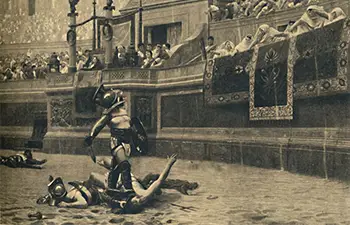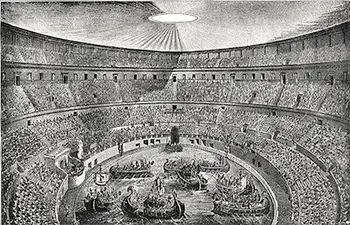The Roman Colosseum
The Colosseum, also known as the Flavian Amphitheater, was the largest amphitheater in the world, measuring about 600 feet long by about 50 feet wide by about 150 feet tall. (Sources differ on the exact measurements.) Construction began in A.D. 72, during the reign of the emperor Vespasian, and the building was completed eight years later, during the reign Vespasian's son Titus. The four-story freestanding structure had 80 arched entrances. Travertine and tufa were the two kinds of limestone-based stone used Seating for 50,000 filled the interior. No admission was charged. Seating had zones, and membership in the zones usually came down to wealth. Visitors entered through 76 of the 80 archways; two were reserved for the emperor, and the other two were reserved for the people and animals doing the fighting in the arena.
Common forms of entertainment within the Colosseum's confines were gladiator challenges, man versus beast struggles, mock naval battles (for which the organizers used special channels to fill and then drain the floor of the structure), music and drama festivals. A total of 36 trapdoors were used for special effects, including the surprise appearance of new combatants. Some emperors also used the Colosseum as a forum for public executions. For events like animal hunts, organizers often decorated the floor of the arena with appropriate elements of setting, such as rocks and trees. The emperor Vespasian ordered construction to begin in 72. For the site of the giant building he chose the lake of the emperor Nero's pleasure palace. (A statue of Nero, the Colossus Neronis, stood nearby; this is how the amphitheater came to be called the Colosseum.) Vespasian's son, Titus was on the throne when construction finished, in 80. Father and son had presided over the quelling of the Jewish Revolt; money brought back from Judea financed the construction of the Colosseum, and slaves brought back from Judea took part in that construction. To mark the official opening of the amphitheater, Titus ordered 100 straight days of games and other entertainment. Events at the Colosseum did not take place every day. When they did, the emperor was often in attendance, provided that he was in Rome. Some emperors enjoyed the idea of the Colosseum and its entertainment more than others; Commodus liked it so much that he competed a few times. It was the emperor Honorius in 404 who abolished the Colosseum games. Things were quite different in Rome in those days. Romans filled in the underground area, which had been added by Vespasian's second son, Domitian. Above ground, Romans used the area for growing food, conducting meetings, and other things more mundane than public spectacles. An earthquake in 422 damaged the amphitheater, and a succession of emperors ordered repairs during the next few decades. After the end of the Roman Empire, the Colosseum was used sparingly if at all. It was a fortress at one point. A strong earthquake in 1231 tore down the southwest facade. After that, the leaders of Rome had no compunction about using the columns and other stonework as building materials for new Local people have used the Colosseum as stables from time to time. Church and state leaders endorsed restoration projects throughout the 19th and 20th Centuries. A major restoration ran from 1993 to 2000. Today, the Colosseum is one of Rome's most popular tourist attractions, receiving millions of visitors every year. |
|
Social Studies for Kids
copyright 2002–2025
David White



 to build the structure; holding the stones together were iron clamps. Filling the niches were statues. The facade and some seats inside were made of marble. To emphasize the progression of Greek architecture, the bottom columns were Doric, the middle columns were Ionic, and the third-story columns were Corinthian. Dotting the top floor were small rectangular windows and pilasters in the Corinthian style. A large awning atop the structure could protect the inhabitants against wind, sun, and/or rain.
to build the structure; holding the stones together were iron clamps. Filling the niches were statues. The facade and some seats inside were made of marble. To emphasize the progression of Greek architecture, the bottom columns were Doric, the middle columns were Ionic, and the third-story columns were Corinthian. Dotting the top floor were small rectangular windows and pilasters in the Corinthian style. A large awning atop the structure could protect the inhabitants against wind, sun, and/or rain.

 projects. This continued for a few centuries, until Pope Benedict XIV in 1744 prohibited any further masonry raids on the iconic building. Five years after that, the same pope designated the Colosseum a sacred site because of the number of early Christians who had met their deaths in the arena.
projects. This continued for a few centuries, until Pope Benedict XIV in 1744 prohibited any further masonry raids on the iconic building. Five years after that, the same pope designated the Colosseum a sacred site because of the number of early Christians who had met their deaths in the arena.
